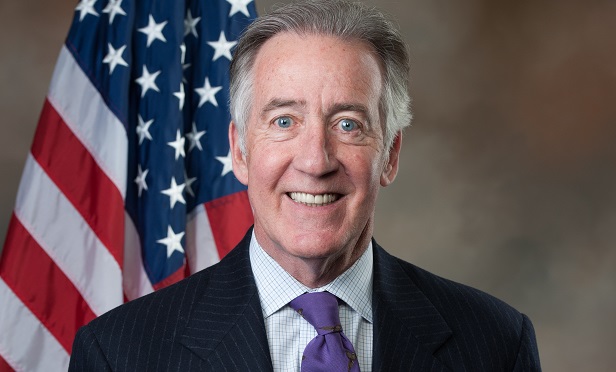 Rep. Richard Neal, D-Mass. (Photo via Neal)
Rep. Richard Neal, D-Mass. (Photo via Neal)
The House is preparing to vote on a measure that could rewire amajor part of the U.S. retirement finance system: H.R.397, the “Rehabilitation for Multiemployer Pensions Act of2019” bill.
|The bill's drafters want to provide financial assistance thatthe managers of the 1,400 multiemployer pension plans in the UnitedStates could use to transfer pension obligations to privateinsurers by purchasing group annuities. If the bill becomes law andworks as the drafters predict, a new Pension RehabilitationAdministration (PRA) and Pension Rehabilitation Trust Fund couldkeep more than 1 million of the 10 million multiemployer pensionplan participants from losing access to the benefits they werepromised.
|Here's more detail on the legislation and the problem it isdesigned to solve:
||
The Multiemployer Pension Plan Problem
The Pension Benefit Guaranty Corp. (PBGC) is the federal agencyresponsible for insuring private pension benefits. Separate lawsgovern how the PBGC provides coverage for single-employerpension plans and for multiemployer pensions. Analysts say that thetypical single-employer plan is reasonably well-funded, but thatmany multiemployer plans look shaky.
|Members of Congress have been talking about the problem foryears. They included a provision creating a Joint Select Committeeon Solvency of Multiemployer Pension Plans in the Bipartisan BudgetAct of 2018.
|In April 2018, Ted Goldman, a pension actuary at the AmericanAcademy of Actuaries, told a hearing of the joint selectcommittee that about 100 of the 1,400 PBGC-insured multiemployerplans appear to be likely to fail within the next 20 years, andthat those plans now serve about 1 million participants andbeneficiaries.
|The PBGC has about $2.2 billion in assets available to supportall multiemployer plan obligations, and it needs $67 billion justto support obligations to participants in the multiemployer plansthat have already failed, Goldman said.
||
What's in H.R. 397?
In January, Rep. Richard Neal, D-Mass., the chairman of theHouse Ways and Means Committee, introduced H.R. 397, which has beendubbed the Butch Lewis Act.
|The bill would provide about $32 billion in multiemployerpension plan rehabilitation loans from 2020 through 2029. The billwould also provide about $39 billion in additional financialassistance over the same 10-year period. The bill classifies thatassistance as loans, but the Congressional Budget Office (CBO) saysthat, under its rules, those payments count as a form of cashassistance, rather than as loans.
|Multiemployer plan managers could choose between using the PRAloans to buy group annuities and creating their own bondportfolios. H.R. 397 would give managers a strong incentive to buygroup annuities, by keeping managers that created their ownportfolios under the oversight of the PRA. Managers that createdtheir own portfolios would have to report on the performance of theportfolios every three years. The PRA could require them to takeremedial action to cure any inadequacies.
|H.R. 397 has attracted 209 co-sponsors, nine of whom areRepublicans. Many are in the Northeast, but Rep. Jeff Fortenberry,R-Neb., and Rep. Bill Huizenga, R-Mich., are in the Midwest. H.R.397 has already been approved by the House Education and LaborCommittee and the House Ways and Means Committee. Members of theHouse Rules Committee are meeting at 5 p.m. EDT today to packagethe bill for floor action.
|House leaders say on their House floor billconsideration website that they could bring H.R. 397 up for avote on the House floor this week.
||
Objections to the Bill
H.R. 397 received many votes of support from Republicans at theHouse Education and Labor Committee, but it received no votes ofsupport from Republicans at the House Ways and Means Committee.
|Critics have argued that the current version of the bill is notreally bipartisan, that it is not funded in a realistic way, andthat the amount of assistance it would provide is too small.
|PBGC figures show that multiemployer plans were just 43 percentfunded, overall, in 2015, according to an analysis from Rep. KevinBrady, R-Texas, that was included in the House Ways and MeansCommittee's official report on the bill. Moreover, about 95 percentof multiemployer plan participants were in plans that were lessthan 60 percent funded. Brady said PBGC-insured multiemployer plansneed about $722 billion to be fully funded.
|“Committee Democrats are moving a partisan bill they know has nochance in the Senate,” Brady said.
|Nevertheless, the fate of H.R. 397 is worth following. Even ifit fails, the bill could end up shaping any multiemployer pensionlegislation that does become law.
|
From: ThinkAdvisor
Resources
- The House Rules Committee site for its H.R. 397 meeting, whichincludes links to several versions of the bill, is availablehere.
- A CBO analysis of the bill is availablehere.
- Joint Committee on Taxation analyses of two versions of thebill are available here and here.
Complete your profile to continue reading and get FREE access to Treasury & Risk, part of your ALM digital membership.
Your access to unlimited Treasury & Risk content isn’t changing.
Once you are an ALM digital member, you’ll receive:
- Critical Treasury & Risk information including in-depth analysis of treasury and finance best practices, case studies with corporate innovators, informative newsletters, educational webcasts and videos, and resources from industry leaders.
- Exclusive discounts on ALM and Treasury & Risk events.
- Access to other award-winning ALM websites including PropertyCasualty360.com and Law.com.
*May exclude premium content
Already have an account? Sign In
© 2024 ALM Global, LLC, All Rights Reserved. Request academic re-use from www.copyright.com. All other uses, submit a request to [email protected]. For more information visit Asset & Logo Licensing.







